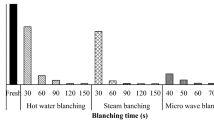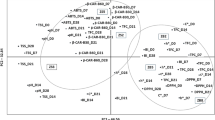Abstract
Lack of nutrients in cooking water, high energetic costs, high water consumption and recycling are some drawbacks of vegetable blanching. Those disadvantages could be bypassed using microwave blanching. Three blanching methods (microwave, boiling water and steaming) were compared in this study in order to determine their effects on some functional properties of broccoli. In addition, the thermal damage on broccoli colour was evaluated. The effectiveness of each blanching process was performed measuring the lost of peroxidase activity, that results more rapidly in microwaves and steam treatments (50 and 60 s respectively) than in boiling water treatment (120 s). The colour indexes did not allow to discriminate a significant difference among treatments. The increase of treatment time caused a vitamin C decrease in samples blanched by boiling water and steam; this trend was not observed in microwaved samples. The phenols content did not significantly vary depending both on type and on time of treatment.









Similar content being viewed by others
References
Akyol C, Bayindirli A, Alpas H (2004) Effect of combined treatment of high hydrostatic pressure and mild heat on peroxidise inactivation in green beans, peas and carrots. Proceedings of IFT Annual Meeting, July 12–16, Las Vegas, NV, USA
Arnnok P, Ruangviriyachai C, Mahachai R, Techawongstien S, Chanthai S (2010) Optimization and determination of polyphenol oxidase and peroxidase activities in hot pepper (Capsicum annuum L.) pericarb. Int Food Res J 17:385–392
Arroqui C, Rumsey TR, Lopez A, Virseda P (2001) Effect of different soluble solids in the water on the ascorbic acid losses during blanching of potato tissue. J Food Eng 47:123–126
Bahçeci KS, Serpen A, Gökmen V, Acar J (2005) Study of lipoxygenase and peroxidise as indicator enzymes in green beans: change of enzyme activity, ascorbic acid and chlorophylls during frozen storage. J Food Eng 66:187–192
Barrett DM, Garcia EL, Russel GF, Ramirez E, Shirazi A (2000) Blanch time and cultivar effects on quality of frozen and stored corn and broccoli. J Food Sci 65:534–540
Bengtsson GB, Schöner R, Lombardo E, Schöner J, Borge GIA, Bilger W (2006) Chlorophyll fluorescence for non-destructive measurement of flavonoids in broccoli. Postharvest Biol Technol 39:291–298
Berek HE, Wickersheim KA (1988) Measuring temperatures in microwavable packages. J Packag Technol 2:164–168
Brody AL (1992) Microwave food pasteurization, sterilization and packaging. Food Technology International Europe, 67–71
Buckle KA, Edwards RA (1970) Chlorophyll, colour and pH changes in HTST processed green pea puree. J Food Technol 5:173–186
Fellows P (1987). Blanching. In W.C.H. Publisher, Food Processing Technology, 201–209
Goncalves EM, Pinheiro J, Alegria C, Abreu M, Brandao TRS, Silva CLM (2009) Degradation kinetics of peroxidase enzyme, phenolic content, and physical and sensorial characteristics in broccoli (Brassica oleracea L. ssp. Italica) during blanching. J Agric Food Chem 57(5370):5375
Gunawan MI, Barringer SA (2000) Green colour degradation of blanched broccoli (Brassica oleracea) due to acid and microbial growth. J Food Process Preserv 24:253–263
Gupte SM, El-Bisi HM, Francis FJ (1964) Kinetics of thermal degradation of chlorophyll in spinach puree. J Food Sci 29:379–382
Ihl M, Shene C, Scheuermann E, Bifani V (1994) Correlation for pigment content through colour determination using tristimulus values in a green leafy vegetable Swiss chard. J Sci Food Agric 66:527–531
Knekt P, Kumpulainen J, Jarvinen R, Rissanen H, Heliovaara M, Reunanen A, Halulinen T, Aromaa A (2002) Flavonoids intake and risk of chronic diseases. Am J Clin Nutr 76:560–568
Lancaster JE, Lister CE, Reay PF, Triggs CM (1997) Influence of pigment composition on skin color in a wide range of fruits and vegetables. J Am Soc Hortic Sci 122(4):594–598
Lau MH, Tang J, Swanson BG (2000) Kinetics of textural and color changes in green asparagus during thermal treatments. J Food Eng 45:231–236
Lin S, Brewer MS (2005) Effects of blanching method on the quality characteristics of frozen peas. J Food Qual 28:350–360
Lin CH, Chang CY (2005) Textural change and antioxidant properties of broccoli under different cooking treatments. Food Chem 90(1–2):9–15
Little AC (1975) Off on a tangent. J Food Sci 40:410–411
Liu S, Manson JE, Lee IM, Cole SR, Hennekens CH, Willett WC, Burning J (2000) Fruit and vegetable intake and risk of cardiovascular disease: the Women’s Health Study. Am J Clin Nutr 72:922–928
MacKinney G, Weast CA (1940) Color changes in green vegetables; frozen-pack peas and sting beans. Ind Eng Chem 32(2):392–395
Meyer LM (1960) Food chemistry. Reinhold Publ. Corp, New York
Miglio C, Chiavaro E, Visconti A, Fogliano V, Pellegrini N (2008) Effects of different cooking methods on nutritional and physicochemical characteristics of selected vegetables. J Agric Food Chem 56:139–147
Monero DA, Perez-Balibrea S, Ferreres F et al (2010) Acylated anthocyanins in broccoli sprouts. Food Chem 123(2):358–363
Mudgett RE (1989) Microwave food processing. Food Technol 43:117–126
Oerlemans K, Barrett DM, Suades CB, Verkerk R, Dekker M (2006) Thermal degradation of glucosinolates in red cabbage. Food Chem 95:19–29
Philippon J (1984) Méthodes de blanchiment-refroidissement des legumes destinés a la congélation. Sci Aliment 4:523–550
Podsedek A, Sosnowska D, Redzynia M, Anders B (2006) Antioxidant capacity and content of Brassica oleracea dietary antioxidants. Int J Food Sci Technol 41(1):49–58
Roy MK, Juneja LR, Isobe S et al (2009) Steam processed broccoli (Brassica oleracea) has higher antioxidant activity in chemical and cellular assay systems. Food Chem 114(1):263–269
Salunkhe DK, Kadam SS (1998) Handbook of vegetable science and technology: production, composition, storage and processing. Marcel Dekker (Ed.), New York
Singh J, Upadhyay AK, Kundan P, Anant B, Mathura R (2007) Variability of carotene, vitamin C, E and phenolics in Brassica vegetables. J Food Compos Anal 20:106–112
Steet JA, Tong CH (1996) Degradation kinetics of green colour and chlorophylls in peas by colorimetry and HPLC. J Food Sci 61:924–931
Stewart AJ, Bozonnet S, Mullen W, Jenkins GI, Michael EJ, Crozier A (2000) Occurrence of flavonols in tomatoes and tomato-based products. J Agric Food Chem 48:2663–2669
Sweeney JP, Martin M (1958) Determination of chlorophyll and pheophytin in heated by various procedures. Food Res 23:635–647
Tijskens LMM, Schijvens EPHM, Biekman ESA (2001) Modelling the change in colour of broccoli and green beans during blanching. Innov Food Sci Emerg Technol 2:303–313
Tong CH, Letz RR, Possen JL (1994) Dielectric properties of pea puree at 915 MHz and 2450 MHz as a function of temperature. J Food Sci 59(121–122):134
Turkmen N, Sari F, Velioglu YS (2005) The effect of cooking methods on total phenolics and antioxidant activity of selected green vegetables. Food Chem 93:713–718
Vallejo F, Tomas-Barberan FA, Garcia-Viguera C (2002) Glucosinolates and vitamin C content in edible parts of broccoli florets after domestic cooking. Eur Food Res Technol 215(4):310–316. doi:10.1007/s00217-002-0560-8
Van Loey A, Hendrickx M, De Cordt S, Haentijens T, Tobback P (1996) Quantitative evaluation of thermal processes using time-temperature integrators. Trends Food Sci Technol 71:16–26
Van Loey A, Ooms V, Weemanes C, Van den Broeck I, Ludikhuyze L, Indrawati DS, Hendrickx M (1998) Thermal and pressure-temperature degradation of chlorophyll in broccoli (Brassica oleracea L., italica) juice: a kinetic study. J Agric Food Chem 46:5289–5294
Verkerk R, Dekker M (2004) Glucosinolates and myrosinase activity in red cabbage (Brassica oleracea L., var. capitata f. rubra DC) after various microwave treatments. J Agric Food Chem 52:7318–7323
Viña SZ, Olivera DF, Marani CM, Ferreyra RM, Mugridge A, Chaves AR, Mascheroni RH (2007) Quality of Brussels sprouts (Brassica oleracea L. gemmifera DC) as affected by blanching method. J Food Eng 80:218–225
Williams DC, Lim MH, Chen AO, Pangborn RM, Whitaker JR (1986) Blanching of vegetables for freezing: which indicator enzyme to choose. Food Technol 40(6):130–140
Woolfe ML (1979) Effect of heating on foodstuffs. In: Priesley JR (ed) Pigments. Applied Science Publishers, London, pp 77–119
Yang HW, Gunasekran S (2001) Temperature profiles in a cylindrical model food during pulsed microwave heating. J Food Sci 66:998–1004
Yingjie D, Singh RK, Lee JH (2002) Estimation of temperature profiles in microwaved particulates using enzyme and vision system. Lebensm Wiss Technol 36:331–338
Yuan G, Sun B, Yuan J, Wang Q (2009) Effects of different cooking methods on health-promoting compounds of broccoli. J Zhejiang Univ SCI B 10(8):580–588
Zhang D, Hamauzu Y (2004) Phenolics, ascorbic acid, carotenoids and antioxidant activity of broccoli and their changes during conventional and microwave cooking. Food Chem 88(4):503–509
Author information
Authors and Affiliations
Corresponding author
Rights and permissions
About this article
Cite this article
Severini, C., Giuliani, R., De Filippis, A. et al. Influence of different blanching methods on colour, ascorbic acid and phenolics content of broccoli. J Food Sci Technol 53, 501–510 (2016). https://doi.org/10.1007/s13197-015-1878-0
Revised:
Accepted:
Published:
Issue Date:
DOI: https://doi.org/10.1007/s13197-015-1878-0




